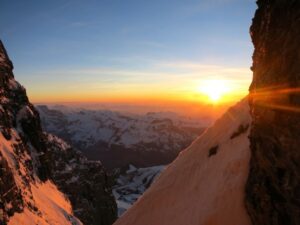
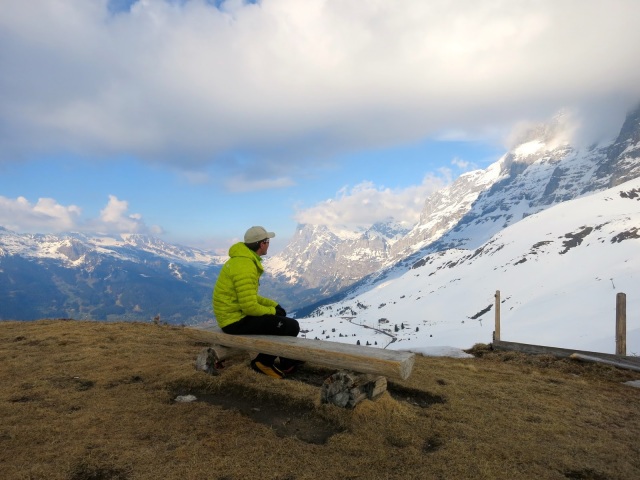
The North face of the Eiger has been on my mind since reading the white spider around 10 years ago. An infamous route more known for the epics where climbers have died than the numerous successful ascents. First climbed 77 years ago with 64 climbers died trying before it was first ascended in 1938. The prospect of attempting to climb it had created much tension, fear and and doubt, but an overriding interest to ‘see for yourself’ was enough to want to climb it.
Several times I have tried to get the right combination of partner, weather, conditions, time off, strength, fitness etc but never happened until now. Recent reports of successful ascents and a clear spell of weather meant the only thing I needed was a strong partner and an understanding wife. Fortunately I have an understanding wife, but unfortunately my usual climbing partners were all busy or not motivated so I went for a long shot and got in touch with a friend I hadn’t seen for a long time, Max Cole. It turned out he had just been on the Les Droites and had the same aspiration of climbing the Eiger and applying for the guide scheme this year. Perfect! The only thing was I had never climbed with him before but I knew he was fit and strong so I wasn’t too concerned.
We made a plan and we met in the car park at the school I work at. I finished my lesson, told the kids what I was about to go and do and if I was delayed someone would cover my lesson in a few days. They wished me luck and I excitedly dashed out to meet Max and we began the journey to Grindlewald to catch the last train up the mountain.

The mountain was shrouded in cloud so was hard to see the route and a sense of foreboding crept in and we hoped it would be clear for the following day. It’s not the place to be caught in a storm as many unfortunate people have found out. We stayed at the Bahnhof in Klein Scheidegg and ate well and got a few broken hours of sleep until 2am. At 2.30 we were ready to get going on the route.
We made good time ascending the easy snow slopes until the ‘difficult crack’ – the first pitch of proper climbing. Here we met 2 other french teams climbing very slowly. We politely asked if we could pass but the weren’t happy for us to climb through so we waited patiently. An hour passed, we were getting cold and concerned and we weren’t prepared to wait any longer so I tried to climb through however we had waited too long for a clean break so then had to wait until the French had gone so we could continue.
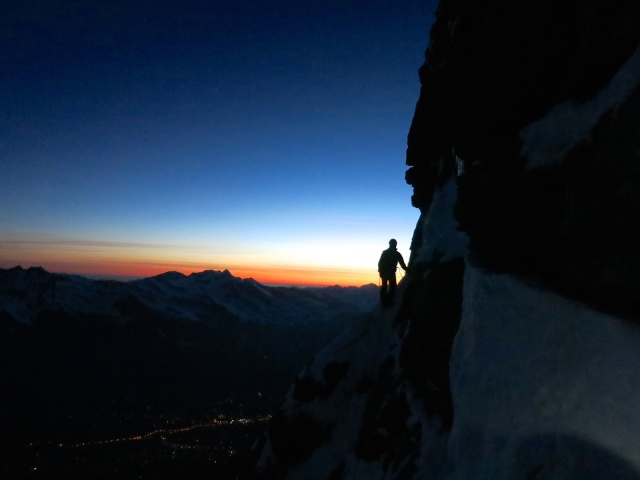
I followed up and found out why it had taken them a while to climb as the name suggests, it is a difficult crack. Edges sloping the wrong way, insecure axe placements and vertical climbing. Thankfully enough insitu gear to clip making it safer. A first taste of the nature of the climbing on the Eiger – insecure steep and sustained.
The ground eased above and Max took over the lead. He ventured upwards at speed clipping a peg then reaching up to a bulge of rock, then… His axe pulled out! He was falling, onto the peg.. His peg pulled out he’s falling again with no other gear, coming towards me at the anchor. Fortunately a snow slope separated us, and Max managed to self arrest before the anchor. Phew!!! Max got up, unhurt, surprised, and slightly embarrassed stating ‘my axe just popped out!’. ‘No shit!’ I thought. He got straight back on it picking up the peg that pulled keeping it as a momento from the face and carried on without any trouble. I didn’t say anything but the thought did cross my mind whether we should carry on. I had never climbed with Max and being committed on a big face with someone is a big thing – it was still possible to turn around. The thought only stayed momentarily as I knew max was solid and it was just a lapse in concentration, it would probably make us both a bit more attentive with placements so I was still confident to carry on.
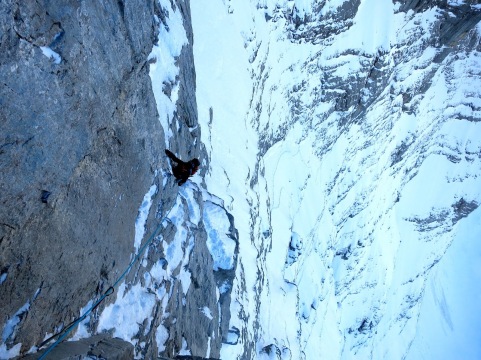
The ground eased and we passed under the Rote Fluhr – a big impressive piece of red rock with some hard sport climbing on it. We crossed the Hinterstoisser traverse really impressed by the steepness and exposed section done such a long time ago and could see how it must have been so difficult to retreat from without a rope in place. Fortunately there’s a big fixed rope now making the section very quick for ascending or retreat.
We were moving well again up the first ice field then onto some very thin ice, with screws placed for confidence more than protection. We caught up with the French teams again as we got onto the second ice field. The face opened up and you could see the route ahead up the ramp and then a seemingly endless face to the summit. We arrived at death bivvy around 9am surprisingly as we had thought we might end up sleeping here. The French had stopped to belay up the ramp and this time I wasn’t prepared to stop and wait so I carried on climbing past them, trying not to annoy the other climbers but it’s just not the place to be waiting around. We were very relieved to get ahead so we could move at our own pace and we made good time moving up the ramp.
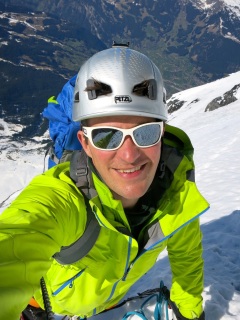
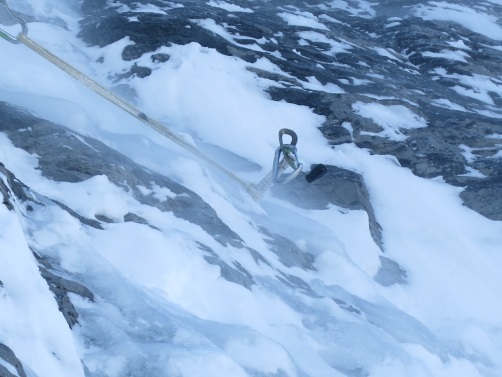
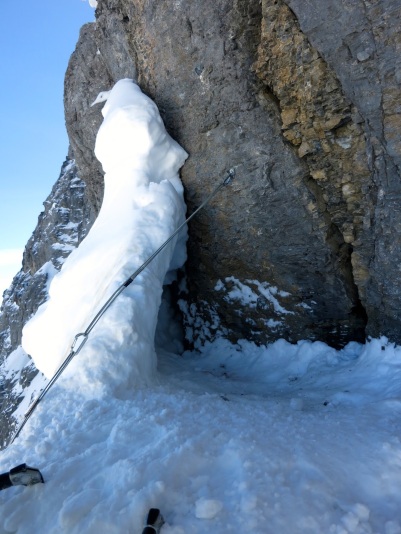
Some awkward climbing took us up to the ‘ice chimney’, – a misleading name as there was no ice. This was definitely the crux pitch with some really insecure placements again and overhanging rock, more like dry-tooling than mixed climbing. Steep and sustained, I am completely in awe of the first ascensionists. It’s hard climbing even with modern equipment. 77years ago with straight axes, crap gear, hemp ropes – this was an outstanding effort!
The ice bulge took us up and onto the brittle ledges traverse which lives up to its name. So much loose rock and an exposed traverse leading to the brittle ledges crack. Again another hard pitch of climbing onto the traverse of the gods and we were both enjoying moving through what was like a mountaineering museum. All these famous pitches and bivvy sites which hold so much history and appear in so much mountain literature.
The realisation we could do it in a day and being fully committed seemed to focus both our minds as we upped the pace even though we were getting very tired. We made good time moving up the White Spider passing an English pair who had been on the face for a couple of days. Just one more pitch of Hard-ish climbing up the ‘quartz crack’ leading into the exit chimneys then a romp to the top we told ourselves – mentally preparing for the remainder of the route. My lead up the quartz crack which turned out to be quite scary late in the day. The evening sun had melted the ice making it feel very precarious and again, thankfully fixed gear made it much safer.
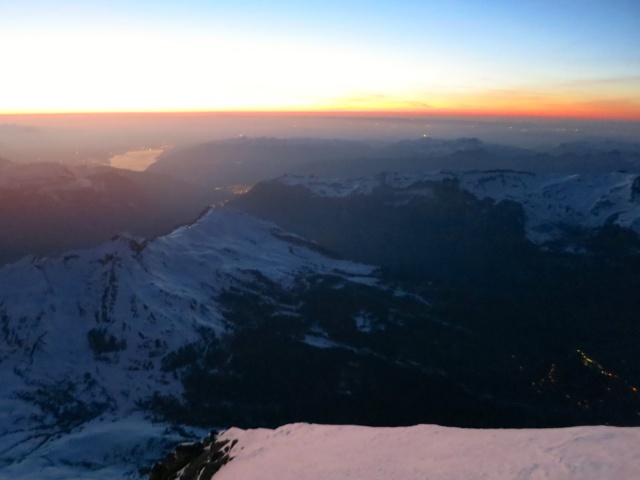

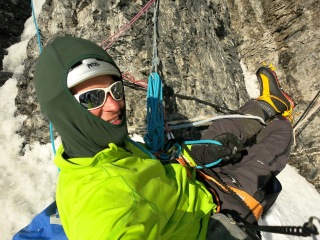
Reaching the top of the quartz crack was a massive relief, the last proper pitch of climbing. I thought it was time to let Kerry know all was well and we would be on the top before long. She was very surprised and also relieved, it can’t be nice worrying about your partner on such a notorious face. The exit cracks went with ease and we were romping up to the summit just as the sun was setting. Amazing views of the mountains in a beautiful warm evening light. I was so chuffed to be there and having completed this famous route in good style! We just had to find somewhere to bivvy for the night which turned out to be harder than we thought.
The ridge line seemed to keep on going for an eternity, both of us very tired and making sure each placement was solid as a slip now would send us both all the way back down the mountain. We still hadn’t found a bivvy site by the end of the ridge so we decided to start descending until we found something/anything. After an hour or so we came to a rock on the West flank which wasn’t a great place but we were both very tired and needed to sleep before continuing to descend so we didn’t make any mistakes. Max started cutting in a ledge and I got a rope round the block for security before we got into our bags and brewed up some soup and noodles. We had been on the go for 22hours without much food or drink so we were both very happy to sit and rehydrate. It wasn’t a good bivvy site, semi hanging, but I was so tired I still managed to sleep for a few hours until dawn.
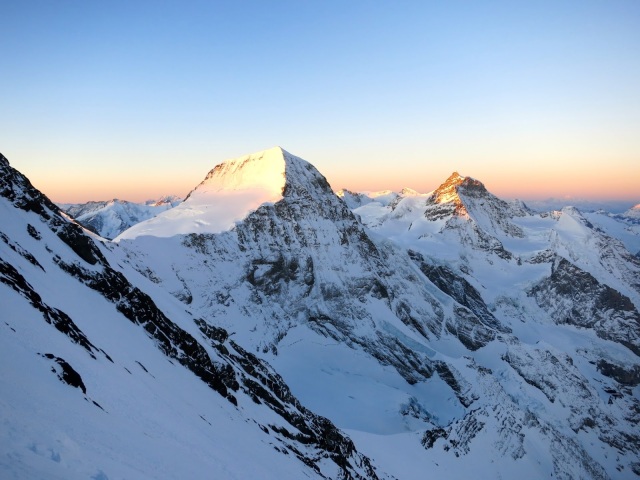
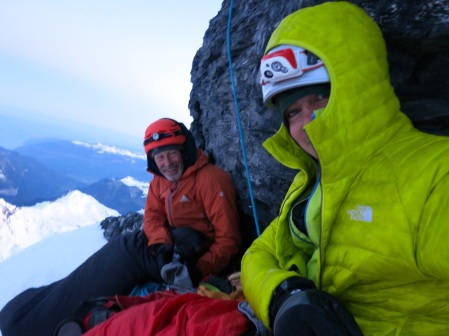
It was an incredible sunrise and a silhouette of the Eiger appeared on the horizon. We were both really chuffed to have made it here in a day and we took our time brewing up in the morning before continuing the descent. The west flank seemed in good condition with good snow cover making the descent straightforward. Calves were burning and body was tired but knowing we would be back to the base soon motivated us to carry on moving quickly. We arrived at the Eigergletscher station around 10, congratulated each other and boarded the train taking us back down to Grindlewald.
It had been a great trip up such an iconic mountain. We had climbed it quickly and in good style and really enjoyed the climbing. Max had been a solid partner and we had climbed well together. It is a big face and still considered a big achievement today in Mountaineering but nothing in comparison to that of the pioneers who first put up this route. Trying to imagine the gear they had to climb with and the uncertainty of whether it was possible, they were literally climbing with a high chance they would die trying. It is a completely different prospect now and with so much fixed gear I can’t help but feel this takes away from the adventurous feel of the route. It’s now a mountain that people are guided on and inevitably more and more fixed gear will appear making it safer. Of course that’s not a bad thing but the brilliance of the first ascent could easily be forgotten with the hardest pitches of the route now effectively made into a ‘sport climb’. Just a very different prospect climbing it now than 77 years ago.